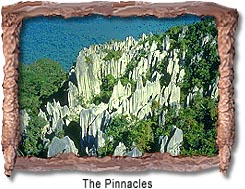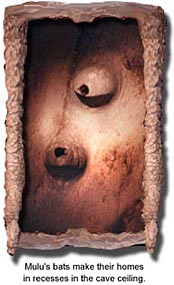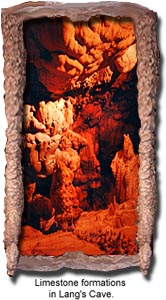| MULU
CAVES Continued
But I was already going to Gunung Mulu National Park, home of one of the world's most extraordinary cave systems, for a much different reason. The park, which is as large as Singapore, is also an incomparable place to experience the wonders of the Malaysian rain forest, the oldest on Earth. To get there, you can either take a bus from the sleepy city of Miri, followed by a boat rides up the Baram River - or take a twenty minute plane ride from Miri. The plane ride is by far the most popular method, because on a clear day the pilot will buzz the park's most striking above-ground feature, a serrated ridge of towering peaks called the Pinnacles. Once you get to Mulu, there are two places to stay: either in the lodges just outside the park, or in the Royal Mulu Resort, a comfortable, tree-house of a hotel situated in the middle of the jungle. Over 1,500 species of plants thrive in Mulu's jungle, including the world's largest flower, the dog-eared Rafflesia, and at least 170 kinds of orchids. Numbers like that are really just abstractions. Gunung Mulu is really just pure green madness. On my first jungle-walk, I felt like I was walking through a blast zone in which the bomb had been life. For every inch of eyesight, my expert guide, a multilingual local from a nearby Berawan village, pointed out some ingenious display of nature's creativity; whether it was in the monumental weavings of the stranger fig vines or the tiny ribbings on the wings of a leaf insect. On the same walk, we ran into a very animated entymologist from New Zealand who had arrived a few days earlier to study a rare-species of spider that had remarkably acute vision. I asked him if he was enjoying himself. "You might think I'm kidding," he replied, "but this place actually does resemble my personal concept of heaven." What makes it all the better, however, is that in Gunung Mulu you don't have to slog through the forest's steamy undermush with a machete in order to fully witness its beauty. The park has over 25 kilometers of plank walkway that keep you high and dry, and it is wide enough so that you can always spot a large insect or snake from a distance, though these creatures prefer to avoid humans. The walkway took over two years to construct, and though it is an idyllic way to see the forest, its main purpose was to provide easy access to the Mulu Caves.
Though I didn't really believe him, I followed him as he tramped off down the walkway towards towards room 101 in the Ministry of Love. There are four caves open to the general public in Gunung Mulu, each with its own unique attraction. Our first stop was the smallest, called Lang's Cave, which is known for its limestone formations. This cave was discovered by Jacob's cousin, a Berawan man named - yes - Lang. A gifted hunter, Lang was tracking a wild boar up the side of the mountain when he came across the cave. When he saw its size and the amazing limestone formations near its mouth, he knew he had found something special, but told no one of his discovery. "He got selfish," Jacob explained. "There were so many boar living near the cave that every time he went hunting he came back successful. It made him look good with the women, so kept it secret. " But the other men in the tribe finally prodded Lang into revealing the secret spot. After that, word of the cave spread quickly.
Home | Places | People | History | Nature | Activities | Features | Fun | Essentials | Calendar |
 "These aren't those kind of
caves," she assured me. When I asked her to explain,
exactly, what other kinds of caves there were besides
ones that immolated you with an invisible and demonic
Hurculean vice, she hit me with the old sucker-punch:
"You'll see," she said. I hate that.
"These aren't those kind of
caves," she assured me. When I asked her to explain,
exactly, what other kinds of caves there were besides
ones that immolated you with an invisible and demonic
Hurculean vice, she hit me with the old sucker-punch:
"You'll see," she said. I hate that.  The
Caves, by far, are the park's biggest draw. It seemed
like I would never hear the end of them. The Kiwi
entymologist and I were probably the only two people who
had come for the forest, and even he couldn't stop raving
about them. "They're like nothing else, mate. You
must see them." When I told my guide, Jacob, that I
was a claustrophobe, he was completely unfazed.
"Maybe in other caves you have problem, not in
Mulu," he said, "I give you my word. C'mon,
I'll show you."
The
Caves, by far, are the park's biggest draw. It seemed
like I would never hear the end of them. The Kiwi
entymologist and I were probably the only two people who
had come for the forest, and even he couldn't stop raving
about them. "They're like nothing else, mate. You
must see them." When I told my guide, Jacob, that I
was a claustrophobe, he was completely unfazed.
"Maybe in other caves you have problem, not in
Mulu," he said, "I give you my word. C'mon,
I'll show you."  The
entrance to Lang's Cave immediately struck me as a pair
of oval jaws, stalactite teeth included. I, of course,
was lunch. Jacob had given me that bull about "his
word" because he was really not a guide at all, but
the man in charge of feeding the caves. Once he coaxed me
inside, however, I saw that it was spacious (though
nothing compared to what would come later) enough to
accommodate my neurosis, and well-lit by electric lights.
As we made our way down a cement pathway, I was so
captivated by what I saw that my phobia took a back seat.
There were whole walls of ice-cream cones, glistening
with moisture and melting down to the floor. There were
miniature rain forests, clouds, and ceilings of boiling
caramel. There were royal chambers, complete with
elaborate gilded thrones and columns and imperial
poster-beds. It was Ali-Baba's cave, with all the stolen
treasure turned to stone.
The
entrance to Lang's Cave immediately struck me as a pair
of oval jaws, stalactite teeth included. I, of course,
was lunch. Jacob had given me that bull about "his
word" because he was really not a guide at all, but
the man in charge of feeding the caves. Once he coaxed me
inside, however, I saw that it was spacious (though
nothing compared to what would come later) enough to
accommodate my neurosis, and well-lit by electric lights.
As we made our way down a cement pathway, I was so
captivated by what I saw that my phobia took a back seat.
There were whole walls of ice-cream cones, glistening
with moisture and melting down to the floor. There were
miniature rain forests, clouds, and ceilings of boiling
caramel. There were royal chambers, complete with
elaborate gilded thrones and columns and imperial
poster-beds. It was Ali-Baba's cave, with all the stolen
treasure turned to stone.